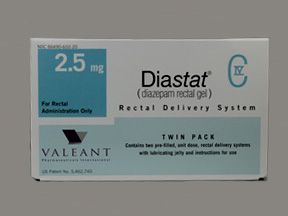Diastat (diazepam) is a prescription drug used as needed to manage seizure clusters resulting from a certain kind of epilepsy. The drug comes as a rectal gel.
Diastat is prescribed to treat seizure clusters in adults and some children with intractable epilepsy. This term refers to epilepsy that isn’t well-managed with anti-seizure medications.
The active ingredient in Diastat is diazepam. (An active ingredient is what makes a drug work.) Diastat belongs to a group of drugs called benzodiazepines.
This drug is available in two versions: Diastat and Diastat AcuDial. Both come as a gel inside prefilled syringes. (AcuDial refers to a special type of syringe.) The gel is injected into the rectum through a flexible tip at the end of the syringe.
Both Diastat and Diastat AcuDial contain the same drug in gel form. While this article focuses on Diastat, the information also applies to Diastat AcuDial unless otherwise noted.
The following text describes the dosages of Diastat, as well as its strengths and how it’s given.
Diastat’s recommended dosage depends on your age and body weight. The following information describes the usual dosages of Diastat. Dosages are listed in milligrams of drug per kilogram of body weight (mg/kg). For reference, 1 kg is about 2.2 pounds (lb).
Note: This table highlights the basics of Diastat’s dosage. Be sure to read on for more details.
| Age | Recommended dose |
|---|---|
| 2 to 5 years | 0.5 mg/kg |
| 6 to 11 years | 0.3 mg/kg |
| 12 years and older | 0.2 mg/kg |
What is Diastat’s form?
Diastat comes as a gel in a prefilled syringe. The gel is injected into the rectum through a flexible tip at the end of the syringe.
Each brand uses a different kind of syringe:
- Diastat uses a standard syringe with a flexible tip.
- Diastat AcuDial uses a special syringe with a display window that shows the dosage. A green “ready” band lets you know when a dose is ready to be given. This syringe also has a flexible tip.
What strengths does Diastat come in?
Diastat is available in one strength: 2.5 mg. Diastat AcuDial is available in two strengths: 10 mg and 20 mg.
What are the usual dosages of Diastat?
Your doctor will prescribe the Diastat dosage that’s right for you based on your body weight and age. Your doctor may further adjust your dosage based on the severity of your condition, your overall health, and other medications you’re taking.
Diastat is used only as needed, up to five times per month. You should not receive it more than once within a 5-day period.
Here you’ll find dosages that are commonly prescribed or recommended. But be sure to follow the dosage instructions your doctor prescribes for you. They’ll determine the best dosage to fit your needs.
Dosage for seizures
Diastat is available in certain strengths. Your doctor will calculate your dose based on your weight in kg, rounding up to the nearest available strength.
The recommended dose for adults is 0.2 mg/kg. Diastat doses are usually available in increments of 2.5 mg. As an example, if you weigh 70 kg (about 154 lb), your doctor will likely prescribe a Diastat dose of 15 mg.
What’s the dosage of Diastat for children?
Diastat can be prescribed to children ages 2 years and older.
The Diastat dose for children is based on their body weight and age. Your child’s doctor will calculate their dosage and round up to the nearest available strength.
Dosage for children ages 2 to 5 years
For children ages 2 to 5 years, the Diastat dose is calculated at 0.5 mg/kg and then rounded up to the nearest available dose. The following table lists example doses for children in this age range.
| Body weight | Diastat dose |
|---|---|
| 6 to 10 kg | 5 mg |
| 11 to 15 kg | 7.5 mg |
| 16 to 20 kg | 10 mg |
| 21 to 25 kg | 12.5 mg |
| 26 to 30 kg | 15 mg |
| 31 to 35 kg | 17.5 mg |
| 36 to 44 kg | 20 mg |
Dosage for children ages 6 to 11 years
For children ages 6 to 11 years, the Diastat dose is calculated at 0.3 mg/kg and then rounded up to the nearest available dose. The following table lists example doses for children in this age range.
| Body weight | Diastat dose |
|---|---|
| 10 to 16 kg | 5 mg |
| 17 to 25 kg | 7.5 mg |
| 26 to 33 kg | 10 mg |
| 34 to 41 kg | 12.5 mg |
| 42 to 50 kg | 15 mg |
| 51 to 58 kg | 17.5 mg |
| 59 to 74 kg | 20 mg |
Dosage for children ages 12 years and older
For children ages 12 years and older, the Diastat dose is calculated at 0.2 mg/kg and then rounded up to the nearest available dose. The following table lists example doses for children in this age range.
| Body weight | Diastat dose |
|---|---|
| 14 to 25 kg | 5 mg |
| 26 to 37 kg | 7.5 mg |
| 38 to 50 kg | 10 mg |
| 51 to 62 kg | 12.5 mg |
| 63 to 75 kg | 15 mg |
| 76 to 87 kg | 17.5 mg |
| 88 to 111 kg | 20 mg |
Is Diastat treatment long term?
Diastat is not a maintenance medication. That is, you won’t use it daily on a long-term basis to help prevent seizures. Diastat is meant to be administered as needed to treat seizure clusters.
That said, if you and your doctor determine that Diastat is safe and effective for your condition, you’ll likely use it long term on an as-needed basis.
If you have questions about how long your Diastat treatment will likely last, talk with your doctor.
Dosage adjustments
If you have a serious health condition or are age 65 years or older, your doctor may prescribe a lower dosage. This can reduce your risk of drowsiness or problems with muscle control and coordination.
If you have questions about whether your dosage should be lowered, talk with your doctor.
The dosage of Diastat you’re prescribed may depend on several factors. These include:
- the severity of the condition you’re receiving the drug to treat
- your age
- your body weight
- other conditions you may have (see the “Dosage adjustments” section)
Diastat comes as a gel in a prefilled syringe. The gel is injected into the rectum.
You won’t inject the Diastat gel yourself. Your doctor will provide instructions and train your caregiver or another person on how to recognize your seizure clusters and give you the correct dose of Diastat.
Diastat comes in two kinds of syringes. Each is prefilled with a gel that’s injected through a flexible tip into your rectum. When you experience seizure clusters, the person trained to give you Diastat will give you a dose to try to stop the seizure.
After you receive a Diastat dose, the trained person will stay with you for 4 hours to make sure you’re safe. They will monitor your breathing and skin color to check whether it becomes paler than usual. They will also watch for any side effects from Diastat.
To learn more about Diastat treatment, see Diastat’s prescribing information or talk with your doctor. You can also ask your doctor or pharmacist for information on the expiration, storage, and disposal of Diastat.
Accessible drug containers and labels
Some pharmacies provide medication labels that:
- have large print or use braille
- feature a code you can scan with a smartphone to change the text to audio
Your doctor or pharmacist may be able to recommend pharmacies that offer these accessibility features if your current pharmacy doesn’t.
Diastat has a boxed warning for the risk of misuse and addiction. Misuse refers to taking a drug in a way other than how a doctor prescribes it. With addiction, a drug is used even if it’s causing harmful outcomes.
Benzodiazepines such as Diastat are controlled substances and are classified as Schedule IV prescription drugs. This means there is a small risk of misuse during treatment with Diastat. Examples of misuse are using the drug more often or at higher doses than recommended by your doctor.
You should use Diastat only as your doctor has prescribed. Misuse and addiction increase the risk of overdose, which can lead to severe effects, such as difficulty breathing and coma, and can even be fatal.
To learn more, see the “Boxed Warnings” section near the beginning of this article.
Do not receive more Diastat than your doctor prescribes, as this can lead to serious side effects. Diastat should only be given to you when you’re having a seizure and by a trained caregiver. Do not try to give yourself a dose of Diastat.
Symptoms of overdose
Symptoms caused by a mild to moderate overdose can include:
- confusion
- drowsiness
- decrease in muscle tone and strength
- slowed reflexes
- problems with coordination and balance
In rare cases, symptoms of a mild to moderate overdose may also include:
- agitation
- irritation
- violent behavior
- talkativeness
A severe overdose may cause slowed breathing or coma.
It’s important to note that the risk of death from overdose is higher when Diastat is mixed with opioids or alcohol.
What to do in case you receive too much Diastat
Call your doctor right away if you think you’ve received too much Diastat. You can also call 800-222-1222 to reach America’s Poison Centers or use its online resource. But if you have severe symptoms, immediately call 911 (or your local emergency number) or go to the nearest emergency room.
Diastat is a benzodiazepine. It has the potential to cause physical dependence and withdrawal symptoms and has a boxed warning for this risk. With dependence, your body needs the drug to function as usual. Withdrawal symptoms are side effects that can occur when you suddenly stop taking a drug that your body has become dependent on.
If you receive Diastat only once per week or once every few weeks to treat your seizure clusters, you’re unlikely to develop a dependence on the medication. But if you receive it more frequently or at higher doses, there is a risk of dependence.
If you do develop a dependence on Diastat, lowering your dose or stopping treatment suddenly may lead to withdrawal symptoms. Withdrawal can cause seizures and be life threatening.
Symptoms of withdrawal that happen shortly after your dose is lowered or you stop receiving Diastat may include:
- anxiety and panic attacks
- digestive problems (nausea, vomiting, diarrhea, weight loss)
- fast heartbeat
- tremors
- seizures
- hallucinations (seeing or hearing something that’s not really there)
- psychosis (difficulty recognizing what’s real and what isn’t real)
Symptoms of withdrawal that can last for weeks or months after your dose is lowered or you stop receiving Diastat can include:
- problems with remembering, making decisions, and learning new things
- depression
- insomnia (difficulty sleeping)
- ringing in the ears
- muscle twitches
If you think your dose should be lowered or if you’d like to stop your Diastat treatment, talk with your doctor first. This is especially important if you’ve been receiving Diastat more than once every 5 days or at higher doses than prescribed. Your doctor can help you to safely lower your dosage over time.
Disclaimer: Healthline has made every effort to make certain that all information is factually correct, comprehensive, and up to date. However, this article should not be used as a substitute for the knowledge and expertise of a licensed healthcare professional. You should always consult your doctor or another healthcare professional before taking any medication. The drug information contained herein is subject to change and is not intended to cover all possible uses, directions, precautions, warnings, drug interactions, allergic reactions, or adverse effects. The absence of warnings or other information for a given drug does not indicate that the drug or drug combination is safe, effective, or appropriate for all patients or all specific uses.





